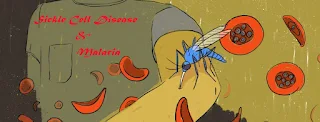People with Sickle Cell Trait (SCT) often don’t have
malaria because their system consists of 1 altered gene and 1 normal gene. SCT
originated in areas with high malaria infections. SCT has been proven to have a
protective effect against malaria.
Remember, malaria is so deadly that more than 40 million
people die of it yearly. Apart from protecting SCT carriers from malaria, SCT
doesn’t benefit people in any other way.
Where is malaria found?
It can be found in areas with a tropical climate that has
parasites and Anopheles mosquitos. These areas are Africa, South Asia and South
America.
What is the relationship between sickle cell disease and
malaria?
The rate at which malaria infects people with SCT is not
as high as that of those with normal hemoglobin. People living with SCT have
between 50-90 % fewer parasites in their blood than those with normal
hemoglobin. The parasites also get out of those with SCT faster.
If you compare people with normal hemoglobin and malaria
to those with SCT and malaria, you will notice that the latter:
• Have
lower cases of malaria
• Have
lower admissions in hospitals
• Have
lower blood transfusions rates
• Are
unlikely to die from malaria
• Are
unlikely to get bacteremia (blood infection)
In what way does sickle cell trait protect people against
malaria?
Malarial parasites attack normal red blood cells to the
point of rearranging their content. These parasites breed and form proteins that
make red blood cells sticky. This causes the explosion of the blood cells which
release parasites that in turn infect other red blood cells.
The distorted SCT hemoglobin affects the ability of the
parasite to complete this cycle. The parasite causes the SCT hemoglobin to
sickle. This makes the immune system clear the infected red blood cells which
helps the parasite to complete its life cycle, infecting other red blood cells.
All this leads to fewer parasites and minor illnesses.
The history of sickle cell trait and malaria
The areas with the most cases of malaria are also the
areas with the most number of people with SCT. It’s not by accident.
Imagine how malaria is so deadly that the human body has
devised a means to combat it. By changing the genetic code of hemoglobin,
causing SCT, the infected person has better odds of surviving malaria despite
its high death rate.
Does sickle cell anemia also protect people against
malaria?
Having Sickle Cell Trait protects its carriers from
malaria, but having sickle cell anemia (HbSS) does not. A study conducted in
Kenya on children between 16 months and 2 years old, revealed that children
with HbSS had the slimmest chance of surviving malaria.
On the contrary, children with SCT proved to have the
highest chance of survival. The rate of survival for the ones with normal
hemoglobin was between the ones with SCT and HbSS.1
Why a selection for a gene that causes sickle cell
disease?
/span>
It’s seemingly illogical that SCT would continue
spreading when it can cause SCD.
SCT can be described as a balanced polymorphism. It
refers to a genetic change with both a good and bad impact. The good in this
case is protection against malaria, whereas the bad is that SCT genes have a
chance of being passed on to the carriers’ child who will then get SCD.
SCT comes from places where malaria kills more than
anything else, so anything that renders protection has better odds of being
passed on. But in areas where malaria doesn’t threaten lives, there’s no
benefit of having SCT. Remember, SCT leads to SCD, which lowers life expectancy
and also has serious health problems.
















0 Comments